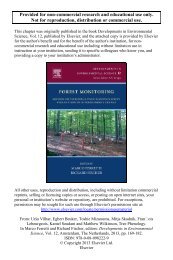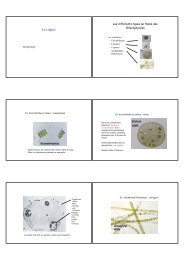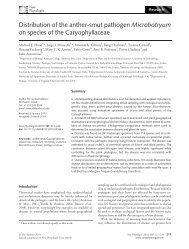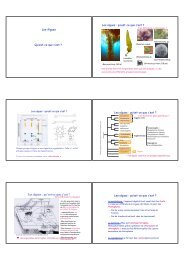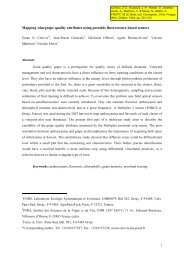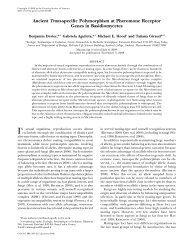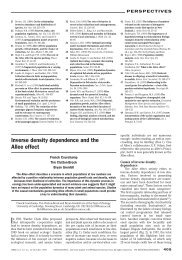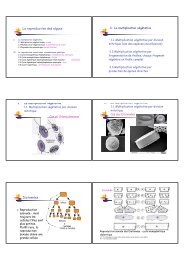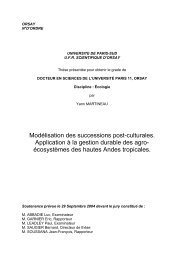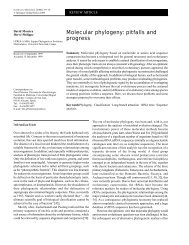In Vivo Respiratory Metabolism of Illuminated Leaves
In Vivo Respiratory Metabolism of Illuminated Leaves
In Vivo Respiratory Metabolism of Illuminated Leaves
Create successful ePaper yourself
Turn your PDF publications into a flip-book with our unique Google optimized e-Paper software.
Tcherkez et al.fixed by photosynthesis, the mass balance equation forCO 2 is as follows:c e 1 r dayd SV M 5 c fixed 1 c o ;where d (L/s) is the air flow through the leaf cuvetteand V M the molar volume. Thus, we have:c fixed 5 c e 1 r dayd SV M2 c o :Case <strong>of</strong> Feeding with a Compound That Hasa Homogeneous Isotope Compositionð2ÞHomogeneous isotopic compounds are not involvedin this study, but the calculation is explained here as itgives a basis to understand the next step, that is, theuse <strong>of</strong> compounds with a heterogeneous isotope composition.The isotope composition <strong>of</strong> the substrate fed to theleaf is denoted as d s. Isotopic mass balance is so thatthe 13 C amount entering the cuvette (c e l e ) plus thatfrom the additional CO 2release (r daySV Ml s/d) is equalto the sum <strong>of</strong> the 13 C amount fixed by the leaf (c fixedl fixed) and the 13 C amount leaving the cuvette (c ol o).That is,c e l e 1 r dayd SV Ml s 5 c fixed l fixed 1 c o l o : ð3ÞNote that the similar relationship with deltas is notcorrect as the strong 13 C-enrichment does not allowone to neglect R compared to 1 so that l 6¼ R. l fixedisobtained with the usual relationship d fixed 5 d o2DD11andEquation 1, where D is obtained before feeding by onlineisotopic measurements (Evans et al., 1986).Substituting Equation 2 in Equation 3 gives:r day 5d 3 c ol o 2 c e l e 1 ðc e 2 c o Þl fixed: ð4ÞSV M l s 2 l fixedIt should be noted that possible 12 C/ 13 C fractionationsthat can occur during the absorption <strong>of</strong> labeledcompounds are neglected here. The effect <strong>of</strong> sucha fractionation is clearly negligible, that is, in the permil order <strong>of</strong> magnitude, compared to the labelinglevel, which is in the percent order <strong>of</strong> magnitude ormore.Case <strong>of</strong> Feeding with a Compound That Has aNonhomogeneous Positional Isotope CompositionThe underlying assumption <strong>of</strong> the previous paragraphis that the substrate is isotopically homogeneous.However, the isotope composition <strong>of</strong> thefeeding substrates used in these experiments is nonhomogeneousso that its different carbon atom positionsdo not have the same D values. <strong>In</strong> such a case, themetabolic reactions that are responsible for the decarboxylation<strong>of</strong> the carbon atoms and their ratesshould be taken into account. For example, this occurswhen Glc or pyruvate is added: the C-1 atom <strong>of</strong>pyruvate is decarboxylated by pyruvate dehydrogenase,while the C-2 and C-3 positions are decarboxylatedby the Krebs cycle (Fig. 1). Similarly, the C-3 andC-4 atom positions <strong>of</strong> Glc are decarboxylated by thepyruvate dehydrogenase reaction, the other beingdecarboxylated by the Krebs cycle. Advantage canthen be taken from this with positionally 13 C-enrichedsubstrates;13 C-1-pyruvate would specifically enrichthe CO 2 produced by pyruvate dehydrogenase, while13 C-2-pyruvate would specifically enrich the CO 2thatcomes from the Krebs cycle. The same applies topositional 13 C-enrichment in Glc.The additional decarboxylations through the pyruvatedehydrogenase (PDH) reaction and the Krebscycle are denoted as r PDH and r K , respectively (Fig. 1).With the relationship r day5 r PDH1 r K, Equation 2 stillworks. For 13 C-1-pyruvate, Equation 3 becomes:c e l e 1 SV Md ðl 1r PDH 1 l c r K Þ 5 c fixed l fixed 1 c o l o ; ð5Þwhere l 1is the 13 C percentage in the C-1 position <strong>of</strong>the labeled pyruvate. l c is the 13 C percentage <strong>of</strong> theother (unlabeled) positions. For 13 C-2-pyruvate, wehave:c e l e 1 SV Mdl c r PDH 1 l c 1 l 2r K25 c fixed l fixed 1 c o l o ; ð6Þwhere l 2is the 13 C percentage in the C-2 (labeled)position <strong>of</strong> pyruvate. l c(unlabeled positions) is thesame as l c<strong>of</strong> Equation 5 ( 13 C-1 enrichment). It can beseen that the two conditions <strong>of</strong> 13 C-enrichment givetwo Equations (5 and 6) so that r PDHand r Kcan bededuced by a substitution procedure. A similar procedureis used for the positional 13 C-enrichment <strong>of</strong> Glc.Rate <strong>of</strong> 13 C-Enriched Substrate Decarboxylationin DarknessThe CO 2 that is produced in darkness after a lightperiod with 13 C-enriched substrate feeding comesfrom respiratory oxidation <strong>of</strong> new photosynthates( 13 C percentage in the fixed carbon l fixed ), photosynthatesfrom the previous light period in the greenhouse( 13 C percentage l previous), and additional Ccoming from the 13 C-enriched substrate fed to the leaf( 13 C percentage l s). It has been previously shown thatthe contribution <strong>of</strong> new photosynthates to dark respirationafter 3-h light in French bean is 40% (Noguéset al., 2004). So the 13 C percentage in photosynthatesfeeding respiration is given by l p5 0.4 l fixed1 0.6l previous. It should be noted that possible variationsin the coefficients due to some physiological reasonsdo only introduce a minor error in the estimate <strong>of</strong> the13 C-enriched substrate decarboxylation r nightbecause<strong>of</strong> the strong 13 C-enrichment in the substrate.The total CO 2production in the dark is denoted asR n. The 13 C percentage in dark respired CO 2(denotedas l global) is calculated with the d 13 C value and Equation1. The 13 C mass balance gives the followingrelationship:1598 Plant Physiol. Vol. 138, 2005
Day <strong>Respiratory</strong> <strong>Metabolism</strong> <strong>of</strong> <strong>Leaves</strong>R n l global 5 r night l s 1 ðR n 2 r night Þl p :Rearranging, it gives:ð7Þr night 5 R n 3 l global2 l p: ð8Þl s 2 l pWhen substrates do not have a homogeneous isotopicdistribution (positional enrichment), Equation 7is completed to:R n l global 5 ðr PDH l 1 1 r K l c Þ 1 ðR n 2 r PDH 2 r K Þl p ð9Þfor the 13 C-1-pyruvate feeding. And similarly, for the13 C-2-enrichment, it gives:R n l global 5 r PDH l c 1 r K 3 l c 1 l 21 ðR n 2 r PDH 2 r K Þl p :2ð10ÞEquations 9 and 10 allow one to extract r PDHand r Kwith a substitution procedure. The method is similarfor 13 C-Glc.RESULTSOn-Line Carbon Isotope Discrimination <strong>of</strong> <strong>Leaves</strong> Fedwith 13 C-Enriched SubstratesThe carbon isotope discrimination during photosynthesis<strong>of</strong> detached French bean leaves before andafter addition <strong>of</strong> 13 C-enriched carbohydrates is shownin Figure 2. Before adding substrates, the carbonisotope discrimination was around 20& in all cases.This is in accordance with the p i/p avalue around0.7 (data not shown). At t 5 60 min,13 C-enrichedsubstrates were added. The overall signature <strong>of</strong> Glcwas 5,500& and that <strong>of</strong> pyruvate was 2,500&. When13 C 1-pyruvate was supplied, the carbon isotope discriminationthen increased to D obs 5 180& as a consequence<strong>of</strong> 13 C 1-enriched pyruvate decarboxylation.The carbon isotope discrimination then slightly decreasedand reached approximately 140&. The on-linecarbon isotope discrimination value increased muchless with 13 C 2-enriched pyruvate, with a maximumvalue <strong>of</strong> D obsaround 50&, indicating that decarboxylationsfollowing Pyr dehydrogenation (i.e. Krebscycle) had very small rates. Glc was hardly decarboxylatedin the light, thus with a very small increasein D obs (up to 35&–40& only).Rates <strong>of</strong> Decarboxylation in the LightThe rates <strong>of</strong> decarboxylation <strong>of</strong> the 13 C-enrichedsubstrates (see Fig. 1 that summarizes the parametersconsidered) in the light were calculated using thecarbon isotope discrimination D obsand are given inTable I. These calculations used a two variable model(see ‘‘Theory’’ section) that is, r PDH, the rate <strong>of</strong> decarboxylationthrough the PDH, and r K , the decarboxylationthrough the Krebs cycle. These rates may becompared to the overall R d. As expected from conclusions<strong>of</strong> Figure 2, the decarboxylation rate <strong>of</strong>pyruvate through the PDH reaction was around 0.05to 0.06 mmol m 22 s 21 , the other decarboxylation ratesbeing very low, under 0.01 mmol m 22 s 21 . Although theeffect <strong>of</strong> decarboxylation <strong>of</strong> 13 C 1-enriched Pyr wasstriking in Figure 2, the decarboxylation rate was lowcompared to day respiration (R d, around 0.6 mmol m 22s 21 ) simply because the labeling was strong in Pyr. It isnoteworthy that the decarboxylation rates were negligiblecompared to the overall R d, so that we arguethat the respiratory pathway was not artefactuallyenhanced in our feeding experiment. Accordingly,the overall R d<strong>of</strong> fed leaves was similar to that <strong>of</strong> thecontrol. Nevertheless, the decarboxylation CO 2 fluxcould have been somewhat underestimated because <strong>of</strong>refixation (see below).Rates <strong>of</strong> Decarboxylation in DarknessAfter 180 min (see Fig. 2), light was switched <strong>of</strong>f andthe carbon isotope composition <strong>of</strong> the CO 2 evolved inthe first 30 min <strong>of</strong> darkness was measured. The d 13 Cvalue <strong>of</strong> respired CO 2with 13 C 1- and 13 C 3-Glc feedingwas approximately 740& and 640&, respectively,and the d 13 C value <strong>of</strong> respired CO 2with 13 C 1- and13 C 2-pyruvate feeding was approximately 520& and290&, respectively (Fig. 2, right). The decarboxylationrates calculated using these values are shown in Table I.r PDHwas around 0.070 mmol m 22 s 21 with either Glcor pyruvate and r Kwith Glc was around the double(0.2 mmol m 22 s 21 ) <strong>of</strong> that with pyruvate. Clearly, thesedecarboxylations witness that leaves oxidized moleculesvia glycolysis in the dark. A similar result wasalready obtained by Stitt and ap Rees (1978) with14 CO 2. When compared to the day decarboxylationvalues, the inhibition by light was around 95% for bothr PDH and r K with Glc and around 30% and 95% for r PDHand r Kwith pyruvate, respectively. <strong>In</strong> other words,light inhibited only partially the pyruvate dehydrogenasereaction and almost stopped the Krebs cycle. <strong>In</strong>the light, the respiratory breakdown <strong>of</strong> Glc into CO 2did not occur through the Krebs cycle or the pyruvatedehydrogenase reaction, simply demonstrating thatthe Glc molecules could not reach these metabolicsteps in illuminated leaves.Metabolic Pathways That Consumed 13 C-Enriched GlcThe weakness <strong>of</strong> Glc or pyruvate decarboxylation inthe light raises the question <strong>of</strong> the fate <strong>of</strong> thesemolecules in the leaf. That is why starch purificationon sample <strong>of</strong> the experiment <strong>of</strong> Figure 2 was made andNMR analysis <strong>of</strong> illuminated leaves fed with positional,fully 13 C-labeled substrates (99% 13 C in a givenposition) was done. The results are shown in Table IIand Figure 3, respectively.13 C-enriched Glc supplied to leaves was directed toSuc synthesis; the 13 C content <strong>of</strong> Suc as a wholePlant Physiol. Vol. 138, 2005 1599
Tcherkez et al.Figure 2. Left, Development <strong>of</strong> the on-line carbon isotope discrimination (D obs) <strong>of</strong> detached bean leaves before and after feedingwith Glc that is 13 C-enriched in C-1 ()) or C-3 (h), or pyruvate that is 13 C-enriched in C-1 (;) or C-2 (:). <strong>In</strong> both positionalenrichment cases, the overall d 13 C values <strong>of</strong> Glc and pyruvate are 5,500& and 2,500&, respectively. The detached leaves arefirst put in distilled water and the light is turned on. The vertical dotted line indicates the moment at which the substrate (Glc orpyruvate) is supplied (t 5 60 min). The horizontal dotted line represents the mean photosynthetic fractionation before substratefeeding (D obs approximately equal to 20&). The gas exchange conditions were 350 mLL 21 CO 2 in 21% O 2 ,22°C, and 450 mmolm 22 s 21 light. Note that the D obs measurements only begin after photosynthesis stabilizes that is, after approximately 30 min inthe light. At t 5 180 min, the light is switched <strong>of</strong>f for dark-respired CO 2measurements. The trends <strong>of</strong> the on-line isotopediscrimination with Pyr feeding are indicated with a solid line. Right, d 13 C value (in per mil) <strong>of</strong> the CO 2 respired in the dark justafter having switched <strong>of</strong>f the light. Same symbols as for the left section.approached 60% in both (C-1 and C-3) enrichmentconditions (Fig. 3, A and B). When 13 C 3-Glc was used,the scrambling <strong>of</strong> carbon atoms appeared, with a smalllabeling <strong>of</strong> all the carbon atom positions in the Glcmoiety <strong>of</strong> Suc ( 13 C content around 4%). This presumablycame from the pentose phosphates cycle. Accordingly,this effect was not seen with 13 C 1 -Glc because thefirst steps <strong>of</strong> the cycle are the dehydrogenation anddecarboxylation <strong>of</strong> the C-1 carbon atom <strong>of</strong> Glc.Surprisingly, starch was also labeled by Glc (TableII); with 13 C 1-Glc and 13 C 3-Glc, the d 13 C value <strong>of</strong> starchwas strongly higher (21.9& and 29&, respectively)than in unfed leaves (231.4&). <strong>In</strong> other words, Glccould feed starch synthesis. Its contribution shouldhave nevertheless been low as the starch amount wasnot significantly different between fed and unfedleaves (Table II). The contribution <strong>of</strong> feeding Glc (inpercent <strong>of</strong> total starch amount), denoted here as s, canbe calculated with the following mass-balance relationship:d 13 C withfeeding 5s 3d 13 C feedingGlc 1ð12sÞ3d 13 C withoutfeedingTable I. Respiration rate and calculated decarboxylations (in mmol m 22 s 21 ) <strong>of</strong> Glc and pyruvate supplied to detached French bean leavesthrough the PDH and the Krebs cycle in the light and in the dark (see ‘‘Theory’’ section for calculation details)Day respiration rates were measured as the slope <strong>of</strong> G/r iR nrelationships (see ‘‘Gas Exchange Measurements’’ section) and are thus total dayrespiratory fluxes in the light. Decarboxylation data are mean and SE <strong>of</strong> three independent measurements. The mean inhibition <strong>of</strong> decarboxylation bylight was calculated as the ratio mean light decarboxylation/mean dark decarboxylation.Control Pyruvate GlcLightR d Day respiration rate 0.632 6 0.125 0.625 6 0.150 0.539 6 0.143r PDH Decarboxylation from the PDH reaction 0.058 6 0.009 0.004 6 0.001r K Decarboxylation from the Krebs cycle 0.005 6 0.004 0.009 6 0.004DarknessR n Dark respiration rate 1.178 6 0.039 1.266 6 0.071 1.331 6 0.115r PDH Decarboxylation from the PDH reaction 0.079 6 0.023 0.070 6 0.015r KDecarboxylation from the Krebs cycle 0.116 6 0.011 0.236 6 0.050i PDH Mean inhibition <strong>of</strong> the PDH reaction by light 27% 94%i K Mean inhibition <strong>of</strong> the Krebs cycle by light 95% 96%1600 Plant Physiol. Vol. 138, 2005
Day <strong>Respiratory</strong> <strong>Metabolism</strong> <strong>of</strong> <strong>Leaves</strong>Table II. Amount and carbon isotope composition (d 13 C) <strong>of</strong> starchfrom detached leaves supplied with 13 C-enriched Glc (d 13 C 5,500&)or 13 C-enriched Pyr (d 13 C 2,500&), 15 mmol L 21 for 2 h in the lightwith 350 mL L 21 CO 2 at 251& (see Fig. 1) after 1 h in the lightwithout feedingData are mean and SD <strong>of</strong> three independent measurements.Conditions Amount d 13 Cmg mg 21 fresh weight&Control (greenhouse) 13.1 6 5.3 228.5 6 0.5No feeding 15.1 6 5.0 231.4 6 1.313 C 1-Glc 15.0 6 3.3 21.9 6 9.013 C 3 -Glc 13.6 6 2.9 29.0 6 9.513 C 1 -Pyr 11.7 6 5.4 216.5 6 3.413 C 2 -Pyr 12.2 6 3.2 229.9 6 1.6that gives s 5 0.5% 6 0.2% and 0.4% 6 0.2% for13 C 1-Glc and 13 C 3-Glc, respectively. This contributionwas very low, but was clearly seen in starch (TableII) simply because the d 13 C value <strong>of</strong> the labeling Glcwas very high. This result indicates that Glc moleculesfrom the cytoplasm (or, more generally, C fromthe fed Glc) could reach the chloroplastic compartmentand enter the starch synthetic pathway.The enriched carbon atoms <strong>of</strong> Glc were almost notredistributed to other positions by metabolic pathways;when supplied with 13 C 1-Glc, the C-6 carbonatoms in leaf Glc, Fru, or Suc were not labeled (Fig.3A). Similarly, when supplied with 13 C 3-Glc, the C-4 carbonatoms in leaf Glc and Fru were not labeled and thecorresponding positions in Suc were only weaklylabeled (4% <strong>of</strong> the 13 C content; Fig. 3B). <strong>In</strong> other words,the scrambling <strong>of</strong> carbon atoms through the triosephosphates and hexose phosphates interconversion(with triose phosphate isomerase and aldolase) wasvery low. This result is consistent with the gas exchangemeasurements <strong>of</strong> Figure 2 in which glycolysisappeared to be stopped so that Glc was not (or veryweakly) decarboxylated.that is, approximately 18% <strong>of</strong> the 13 C supplied in C-1.A similar calculation gives, with 13 C 2 -Pyr, a 13 C loss <strong>of</strong>only approximately 1%.Refixation <strong>of</strong> Decarboxylated CO 2The rate <strong>of</strong> the decarboxylation <strong>of</strong> 13 C-enrichedsubstrates in the light may have been underestimatedby possible refixation <strong>of</strong> CO 2 . If so, the absolute rate <strong>of</strong>refixation is expected to be important when 13 C 1-Pyrwas supplied to leaves as decarboxylation was high inthat case (Table I). Nevertheless, Glc and Fru were notlabeled and Suc was only weakly labeled in the C-3position <strong>of</strong> the Fru moiety (Fig. 3C). Although it isdifficult to quantify such small quantities, this labelingin Suc accounted, as a maximum, for 0.5 mmol g 21 <strong>of</strong>13 C, that is, a 13 C (re)fixation rate <strong>of</strong> 0.009 mmol m 22 s 21during 2 h <strong>of</strong> the treatment in the light. When 13 C 1-Pyrwas supplied to leaves, starch was also labeled (theisotope signature is around 220&, compared to 231&expected; Table II) and this was also a consequence<strong>of</strong> refixation. The amount <strong>of</strong>13 C-enriched carbonin starch was calculated to be 0.2% (similar calculationas for section ‘‘Metabolic Pathways That Consumed13 C-Enriched Glc’’). The starch amount and thepercentage <strong>of</strong> carbon in starch were 0.015 mg mg 21fresh weight and approximately 40%, respectively.This gives a refixation rate (<strong>of</strong> labeled carbon) <strong>of</strong>0.008 mmol m 22 s 21 . The overall refixation rate wouldthus have been, as a maximum, 0.017 mmol m 22 s 21 .This means that the total decarboxylation rate <strong>of</strong>13 C 1 -Pyr would have been 0.058 (see Table I) 1 0.017 50.075 mmol m 22 s 21 and so, the inhibition <strong>of</strong> thePDH reaction by light would have been approximately5% only. The effect <strong>of</strong> refixation in the othercase ( 13 C 2-Pyr) was clearly negligible: starch was notlabeled (Table II) and no labeling could be seen in Suc,Glc, or Fru (Fig. 3D). As the rates <strong>of</strong> decarboxylationwere similar with C-1 and C-3 13 C-enriched Glc,refixation was likely to be negligible in both cases.Metabolic Pathways That Consumed13 C-Enriched PyruvateWhen leaves were fed with 13 C 2-Pyr (99% <strong>of</strong> 13 CinC-2), Ala was (weakly) labeled in C-2, indicating thatPyr had been aminated and citrate was labeled,strongly suggesting that some <strong>of</strong> the Pyr moleculesentered the Krebs cycle (Fig. 3D). Surprisingly, whenfed with 13 C 1-Pyr, leaves had only a few labeled carbonatoms (Fig. 3C). Ala appeared as only weakly labeledin C-1, but this originated mainly from the low detectability<strong>of</strong> carboxyl (2COOH) carbon atoms withNMR. Moreover, the CO 2produced in the light accountedfor an important 13 C loss; using a decarboxylationrate <strong>of</strong> 0.05 mmol m 22 s 21 (Table I), therewas a 13 C loss <strong>of</strong> 350 mmol 13 Cm 22 during the lighttreatment (2 h),while approximately 1,950 mmol Pyrm 22 entered the leaf (5Pyr concentration 3 transpirationrate 5 15 mol L 21 3 18 mLm 22 s 21 3 2 h light),DISCUSSIONThe respiratory metabolism in illuminated leavesis inhibited compared to darkness, as repeatedly shownby gas-exchange measurements (for review, see Atkinet al., 2000). However, the metabolic basis <strong>of</strong> such aninhibition is not well known. We addressed this questionby feeding experiments using 13 C-enriched substratesand followed the 13 C atoms with isotope ratiomass spectrometry and NMR to determine whichmetabolic pathways are inhibited in the light.The Pyruvate Dehydrogenase Activity in the LightThe two main steps responsible for the respiratoryCO 2production are the dehydrogenation <strong>of</strong> Pyr (PDHreaction) and the Krebs cycle (Fig. 1). The carbonatoms that are decarboxylated are not the same inPlant Physiol. Vol. 138, 2005 1601
Day <strong>Respiratory</strong> <strong>Metabolism</strong> <strong>of</strong> <strong>Leaves</strong>Starch Extraction ProcedureThe extraction procedures for starch were similar to that described byTcherkez et al. (2003). Leaf powder was suspended with 1 mL <strong>of</strong> distilledwater in an Eppendorf tube (Eppendorf Scientific, Hamburg, Germany). Aftercentrifugation, the pellet was washed four times with 95% ethanol at roomtemperature and starch was extracted with HCl solubilization and precipitatedwith cold methanol. After lyophilization, starch is transferred to tincapsules (Courtage Analyze Service, Mont Saint-Aignan, France) for isotopeanalysis.NMRPerchloric acid (PCA) extracts were prepared from 5 g <strong>of</strong> frozen leafmaterial as described by Aubert et al. (1996) for phloem cells. Spectra wereobtained on a spectrometer (AMX 400) equipped with a 10-mm multinuclearprobe tuned at 161.9 and 100.6 MHz for 31 P- and 13 C-NMR, respectively. Thedeuterium resonance <strong>of</strong> 2 H 2 O (100 mL added per mL <strong>of</strong> extract) was used asa lock signal.Conditions for 13 C-NMR acquisition utilized 19-ms pulses (90°) at 6-sintervals and a sweep width <strong>of</strong> 20 kHz. Broad-band decoupling at 2.5 Wduring acquisition and 0.5 W during the delay was applied using the Waltzsequence; the signal was digitized using 32,000 data points zero-filled to64,000 and processed with a 0.2-Hz line broadening. 13 C-NMR spectra arereferenced to hexamethyldisiloxane at 2.7 ppm. Mn 21 ions were chelated bythe addition <strong>of</strong> 1 mmol L 21 1,2-cyclohexylenedinitrilotetraacetic acid. Theassignments <strong>of</strong> resonance <strong>of</strong> 13 C peaks were carried out according to Gout et al.(1993). Identified compounds were quantified from the height <strong>of</strong> theirresonance peaks using fully relaxed conditions for spectra acquisition (pulsesat 20-s intervals). Peak intensities were normalized to a known amount <strong>of</strong> thereference compound (maleate) that is added to the sample (internal standard).A carbon atom is here considered to be labeled when its estimated positional13 C proportion 13 C/( 13 C 1 12 C) is more than 2% (the natural abundance isnearly 1.1%).13 C-Enriched MoleculesThe positional 13 C-labeled molecules (99% 13 C in the considered position)were purchased to Eurisotop (Saclay, France). Pyruvate was dissolved indistilled water and pH was corrected to 6.8 with NaOH. To obtain non-fullylabeled solutions, the labeled compounds were mixed with industrial Glc(d 13 C 529&) or pyruvate (d 13 C 5221&) from Sigma. The resulting overallcomposition <strong>of</strong> the Glc and pyruvate solutions was checked to be 5,500& and2,500&, respectively. <strong>In</strong> other words, the 13 C-enriched carbon atom positionhad a composition <strong>of</strong> 47,750& and 8,000&, respectively (the other positionsbeing at 29& and 221& for Glc and Pyr, respectively). The final concentrationwas 0.015 mol L 21 in all cases. The solutions were poured in an Eppendorftube and fed to the leaves through the transpiration stream.ACKNOWLEDGMENTGuillaume Tcherkez acknowledges Salvador Nogués for his help forpreliminary works on dark respiration.Received March 2, 2005; revised April 4, 2005; accepted April 10, 2005;published June 24, 2005.LITERATURE CITEDAffek HP, Yakir D (2003) Natural abundance carbon isotope composition<strong>of</strong> isoprene reflects incomplete coupling between isoprene synthesis andphotosynthetic carbon flow. Plant Physiol 131: 1727–1736Atkin OK, Evans JR, Siebke K (1998) Relationship between the inhibition<strong>of</strong> leaf respiration by light and enhancement <strong>of</strong> leaf dark respirationfollowing light treatment. Aust J Plant Physiol 25: 437–443Atkin OK, Millar AH, Gärdestrom P, Day DA (2000) Photosynthesis,carbohydrate metabolism and respiration in leaves <strong>of</strong> higher plants. <strong>In</strong>RC Leegood, TD Sharkey, S von Caemmerer, eds, Photosynthesis,Physiology and <strong>Metabolism</strong>. Kluwer Academic Publishers,LondonAubert S, Gout E, Bligny R, Marty-Mazars D, Barrieu F, Alabouvette J,Marty F, Douce R (1996) Ultrastructural and biochemical characterization<strong>of</strong> autophagy in higher plant cells subjected to carbon deprivation:control by the supply <strong>of</strong> mitochondria with respiratory substrate. J CellBiol 133: 1251–1263Budde RJA, Randall DD (1990) Pea leaf mitochondrial PDH complex isinactivated in vivo in a light-dependent manner. Proc Natl Acad Sci USA87: 673–676Cornic G (1973) Etude de l’inhibition de la respiration par la lumière chezla moutarde blanche Sinapis alba L. Physiol Veg 11: 663–679Evans JR, Sharkey TD, Berry JA, Farquhar GD (1986) Carbon isotopediscrimination measured concurrently with gas exchange to investigateCO 2 diffusion in leaves <strong>of</strong> higher plants. Aust J Plant Physiol 13:281–292Gerbaud A, André M (1987) An evaluation <strong>of</strong> the recycling in measurements<strong>of</strong> photorespiration. Plant Physiol 83: 933–937Gout E, Bligny R, Pascal N, Douce R (1993) The C-13 nuclear magneticresonance studies <strong>of</strong> malate and citrate synthesis and compartmentationin higher plant cells. J Biol Chem 286: 3986–3992Hanning I, Heldt HW (1993) On the function <strong>of</strong> mitochondrial metabolismduring photosynthesis in spinach (Spinacia oleracea L.) leaves. PlantPhysiol 103: 1147–1154Harding RW, Caroline DF, Wagner RP (1970) The pyruvate dehydrogenasecomplex from the mitochondrial fraction <strong>of</strong> neurospora crassa. ArchBiochem Biophys 138: 653–661Igamberdiev AU, Gardeström P(2003) Regulation <strong>of</strong> NAD and NADPdependent isocitrate dehydrogenases by reduction levels <strong>of</strong> pyridinenucleosides in mitochondria and cytosol <strong>of</strong> Pea leaves. Biochim BiophysActa 1606: 117–125Kok B (1948) A critical consideration <strong>of</strong> the quantum yield <strong>of</strong> Chlorellaphotosynthesis. Enzymologia 13: 1–56Krömer S (1995) Respiration during photosynthesis. Annu Rev PlantPhysiol Plant Mol Biol 46: 45–70Laisk AK (1977) Kinetics <strong>of</strong> Photosynthesis and Photorespiration in C3Plants. Nauka, MoscowLin M, Turpin DH, Plaxton WC (1989) Pyruvate kinase isozymes from thegreen alga Selenastrum minutum. Kinetic and regulatory properties. ArchBiochem Biophys 269: 228–238Marillia EF, Micallef BJ, Micallef M, Weninger A, Pedersen KK, Zou J,Taylor DC (2003) Biochemical and physiological studies <strong>of</strong> Arabidopsisthaliana lines with repressed expression <strong>of</strong> the mitochondrial pyruvatedehydrogenase kinase. J Exp Bot 54: 259–270Nogués S, Tcherkez G, Cornic G, Ghashghaie J (2004) <strong>Respiratory</strong>carbon metabolism following illumination in intact French beanleaves using 13 C/ 12 C isotope labeling. Plant Physiol 136: 3245–3254Ohlrogge JB, Jaworski JG (1997) Regulation <strong>of</strong> fatty acid synthesis. AnnuRev Plant Physiol Plant Mol Biol 48: 109–136Pärnik TR, Voronin PY, Ivanova HN, Keerberg OF (2002) <strong>Respiratory</strong> CO 2fluxes in photosynthesising leaves <strong>of</strong> C 3 species varying in rates <strong>of</strong>starch synthesis. Russ J Plant Physiol 49: 729–735Peisker M, Apel H (2001) <strong>In</strong>hibition by light <strong>of</strong> CO 2evolution from darkevolution: comparison <strong>of</strong> two gas exchange methods. Photosynth Res70: 291–298Pinelli P, Loreto F (2003)12 CO 2 emission from different metabolicpathways measured in illuminated and darkened C 3and C 4leavesat low, atmospheric and elevated CO 2concentration. J Exp Bot 54:1761–1769Plaxton WC (1996) The organization and regulation <strong>of</strong> plant glycolysis.Annu Rev Plant Physiol Plant Mol Biol 47: 185–214Quick WP, Scheibe R, Neuhaus HE (1995) <strong>In</strong>duction <strong>of</strong> hexose-phosphatetranslocator activity in spinach chloroplasts. Plant Physiol 109:113–121Rapp BJ, Miernyk JA, Randall DD (1987) Pyruvate dehydrogenasecomplexes from Ricinus communis endosperm. J Plant Physiol 127:293–306Schäfer G, Heber U, Heldt HW (1977) Glucose transport into spinachchloroplasts. Plant Physiol 60: 286–289Sharp RE, Matthews MA, Boyer JS (1984) Kok effect and the quantumyield <strong>of</strong> photosynthesis: light partially inhibits dark respiration. PlantPhysiol 75: 95–101Plant Physiol. Vol. 138, 2005 1605
Tcherkez et al.Siedow JN, Day DA (2000) Respiration and photorespiration. <strong>In</strong>B Buchanan, W Gruissem, R Jones, eds, Biochemistry and MolecularBiology <strong>of</strong> Plants. American Society <strong>of</strong> Plant Physiologists, Rockville, MDStitt M (1990) Fructose-2,6-bisphosphate as a regulatory molecule inplants. Annu Rev Plant Physiol Plant Mol Biol 41: 153–185Stitt M, ap Rees T (1978) Pathways <strong>of</strong> carbohydrate oxidation in leaves<strong>of</strong> Pisum sativum and Triticum aestivum. Phytochemistry 17:1251–1256Tcherkez G, Nogués S, Bleton J, Cornic G, Badeck F, Ghashghaie J (2003)Metabolic origin <strong>of</strong> carbon isotope composition <strong>of</strong> leaf dark respiredCO 2 in French bean. Plant Physiol 131: 237–244Tovar-Mendez A, Miernyk JA, Randall DD (2003) Regulation <strong>of</strong> pyruvatedehydrogenase complex activity in plant cells. Eur J Biochem 270:1043–1049Trethewey RN, ap Rees T (1994) The role <strong>of</strong> the hexose transporter in thechloroplasts <strong>of</strong> Arabidopsis thaliana L. Planta 195: 168–1741606 Plant Physiol. Vol. 138, 2005



